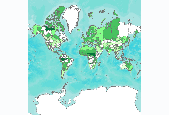Filters: Tags: The Nature Conservancy (X)
183 results (82ms)|
Filters
Date Range
Extensions Types
Contacts
Categories Tag Types
|
The Lower Truckee River originates in the Sierra Nevada and flows through public, private, and tribally owned lands, including 31 miles of the Pyramid Lake Paiute Tribe (PLPT) reservation, terminating in Pyramid Lake within the reservation. Once remarkably productive, a century of man-made changes have heavily degraded the river system, leaving it inundated with invasive weeds. Significant damage occurred as part of a 1960s flood control project, including river downcutting, depression of the groundwater table, and lowering of Pyramid Lake by as much as 81 vertical feet. By the 1970s, the river had lost roughly 90% of its forest canopy, 40% of its resident bird species, and had no resident Kooeyooe (also spelled...

Area of wetlands in each freshwater ecoregion protected under Ramsar Convention. We derived the area of wetlands of international importance protected under the Ramsar Convention in each freshwater ecoregion from a subset of areas included in the World Database on Protected Areas (WDPA) compiled by the UNEP World Conservation Monitoring Centre (UNEP/IUCN 2007). All Ramsar sites in the database were included, except those known to be purely marine in extent, as indicated by the Marine Classes noted as subtidal in the WDPA. Intertidal marine Ramsar sites, however, are included in the analysis because the sites may include both brackish and fresh-waters. Area attributes for those Ramsar sites within the WDPA that...

Number of freshwater bird species, by freshwater ecoregion. Freshwater obligate birds include those species that need freshwater habitats for breeding (e.g., ducks, herons) or feeding (i.e., birds that depend almost exclusively on food found in freshwater habitats, such as freshwater fish, mollusks, and crustaceans). In all, 815 bird species were found to meet this criterion, with almost all bird families represented. We mapped freshwater bird species to freshwater ecoregions with the following procedures: for North and South America, NatureServe GIS data were summarized by freshwater ecoregion; for Africa, distribution maps presented in Birds of Africa (Brown et al. 1982–1997) were used to assign species to freshwater...

Percent of each terrestrial ecoregion's natural habitat that has been converted by humans. The data on the amount of habitat lost was derived from the Global Land Cover 2000 (JRC 2003), which is based on satellite imagery; the Global Rural-Urban Mapping Project (CIESIN et al. 2004); and a global coverage of roads and railroads compiled from ESRI Digital Chart of the World. While the data tell us how much land has been converted from a natural state to a human-altered state for 2000, it does not tell us about any specific type of habitat that has been lost, what it was converted to, how long ago it was converted, or the extent to which the human land use still supports some biodiversity. Because the satellite-derived...

Relative abundance of seagrass habitat, by marine province. We extracted seagrasses from version 2.0 of the global polygon and point data set that was compiled by UNEP-WCMC in 2005 (for more information about the source data set, e-mail spatialanalysis@unep-wcmc.org). These same data were originally published in the World Atlas of Seagrasses (Green and Short 2003; see, in particular, the chapter by Spalding et al. 2003). The source data for the habitat map were a mix of point and polygon information gathered from a major literature review as well as from national-level mapping programs. The habitat distribution information was of varying consistency, with likely gaps in information-poor regions. It was not possible...

Number of snake and lizard species, by terrestrial ecoregion. We compiled data on terrestrial lizards and snakes by querying the WWF WildFinder database for species occurrences by ecoregion of the following taxonomic groups: Sauria, Serpentes, Amphisbaenia, and Rhynchocephalia. The WWF WildFinder database is a spatially explicit online database of vertebrate species occurrences by ecoregion. These data were displayed in a map published in The Atlas of Global Conservation (Hoekstra et al., University of California Press, 2010). More information at http://nature.org/atlas.

Number of fisheries certified as “sustainable and well-managed” by the Marine Stewardship Council (MSC), by marine ecoregion. We obtained information on marine fisheries certified as sustainable and well managed by the Marine Stewardship Council (MSC, www.msc.org) from the MSC Web site’s certified fisheries profiles. Individual fishery profiles described geographic fishing areas where each fishery operates. These areas tend to correspond to national fishing area designations. Using these designations and mapped information on the MSC Web site, we assigned certified fisheries manually and approximated as much as possible to marine ecoregional boundaries. These data were derived by The Nature Conservancy, and were...
|

|